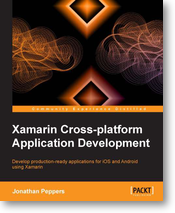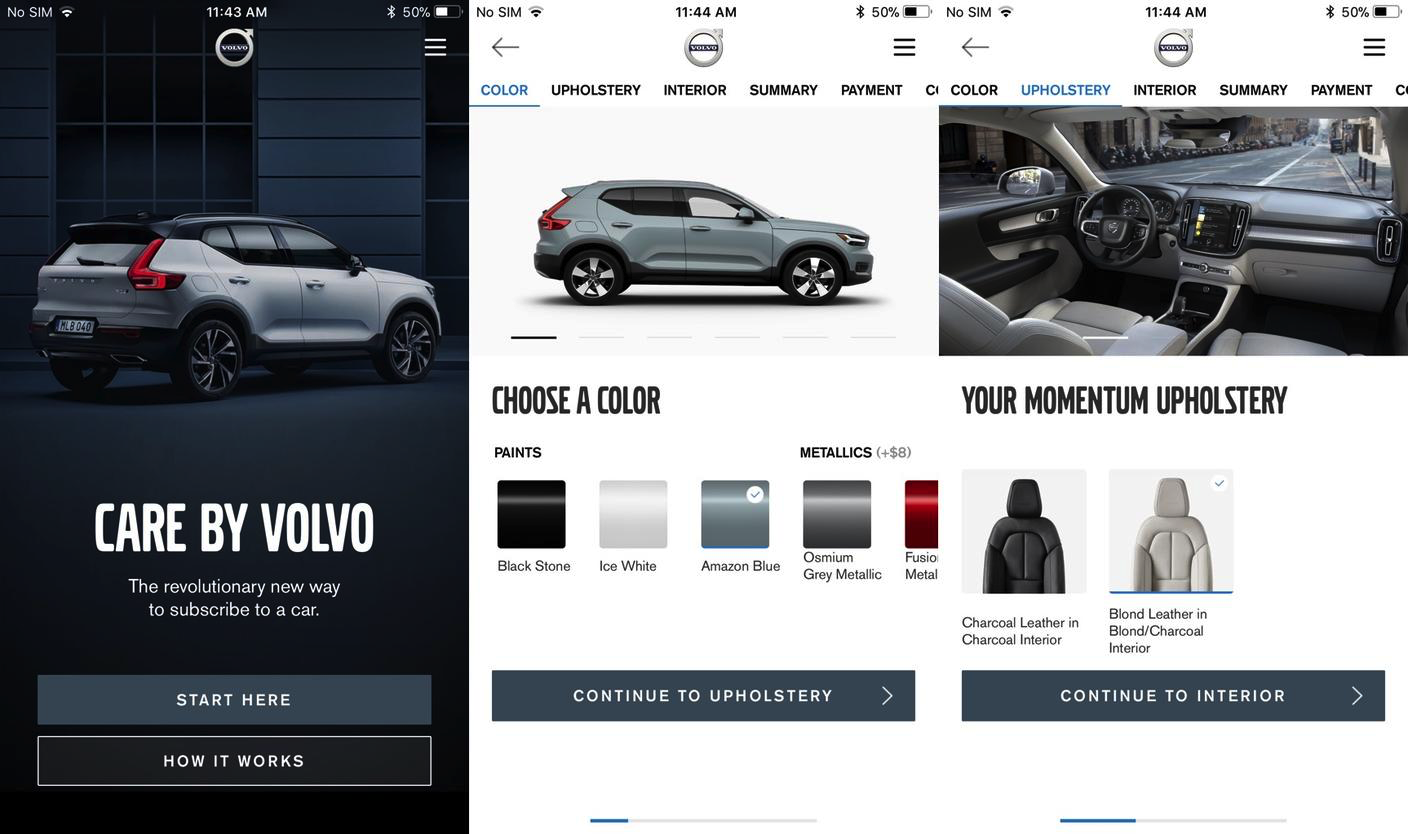Now you can order and pay for a Volvo from an App
From: All you need for a Volvo XC40 subscription is your iPhone:
When I first read this I thought it was too much, but then on rethinking ‘why not?’
You can use any iOS device to run the Care by Volvo app, of course, and both Touch ID and Face ID work to authorize the payment. The app allows you to take a virtual tour of the XC40, configure your own with options and fill out your details for the subscription. All of this right from the app
But the killer comes down to the user experience, as that’s a significant expense and commitment to make whilst sat on the loo!
Wirelessly deploying to an iOS to tvOS device
Feel my pain, we have an Apple TV in the office which runs a dashboard app that we knocked up, however the physical device is in the roof space, behind the TV, and about 10m of cable run from my Mac, the motivators to ‘do a quick update’ are low.
One thing most developers consistently do during app development is deploy to a testing device. One main drawback during this process is the struggle to find a cable, connect it to a computer, plug it into a device, and then finally deploy the app.
Looking forward to trying this, see how it works in reality, ask again later!
Full Article At: Lose the Cables: Make Deploying to an iOS or tvOS Device Easier | Xamarin Blog
Simple Cross-Platform File IO for iOS, Android, and Windows
One of the biggest challenges in Cross Platform Mobile App Development is implementing a mechanism of performing simple tasks on each diverse platform, such as reading a config file on app launch, when you know that each platform will store this file in a different location, have a preference for different file formats, and have different permission mechanisms for reading and writing. This plugin helps nail most of those issues.
Most mobile applications need to interact with the underlying file system. Be it building a database or caching data, some understanding of how file systems work on target platforms is required. If you’re working with multiple platforms, not only does this require understanding of how each individual file system works, but also how to work with the file system from shared code.
The File System Plugin for Xamarin and Windows reduces the underlying file system complexities for each platform into a cross-platform file IO API for iOS, Android, and Windows, making it extremely easy to work with the file system from shared code. In this blog post, you will learn how to use the File System Plugin for Xamarin and Windows to create, edit, and delete files and directories from shared code.
Introduction to the File System Plugin for Xamarin and Windows
Similar to desktop operating systems, mobile operating systems each have their own file system. Building applications that target multiple operating system requires knowledge of not just one file system, but the underlying file system for each platform. Another barrier when working with file systems is the inability to use code that talks to individual file systems in shared code. A common solution to this problem is to use preprocessor directives (#ifdefs) to access platform-specific features, but this won’t work with PCLs and results in messier code.
Plugins for Xamarin expose platform-specific functionality via a cross-platform API that can be consumed from a Portable Class Library or Shared Project, such as using device geolocation, sending an SMS, or storing app settings, to help make you share even more code and increase developer productivity. The File System Plugin for Xamarin and Windows makes working with the many different mobile file systems easy with a shared, cross-platform API. You can download the plugin using the Xamarin Component Store or via the NuGet Package Manager.
Exploring the APIs
The IFileSystem interface represents an abstracted file system at the highest level. The platform-specific implementation can be accessed via the FileSystem.Current property. The file system is made up of a collection of folders and individual files, which are abstracted via the IFolder and IFile interfaces. When creating folders and files, we are also given maximum control over collision detection preferences with theCreationCollisionOption enumeration, which allows us do everything from create an alternative name, replace the existing directory/file, open the existing directory/file, or throw an exception. Of course, all of these APIs are also async/await compatible as well.
1
2
3
4
5
6
7
8
9
10
11
// Access the file system for the current platform.
IFileSystem fileSystem = FileSystem.Current;
// Get the root directory of the file system for our application.
IFolder rootFolder = fileSystem.LocalStorage;
// Create another folder, if one doesn’t already exist.
IFolder photosFolder = await rootFolder.CreateFolderAsync(“Photos”, CreationCollisionOption.OpenIfExists);
// Create a file, if one doesn’t already exist.
IFile selfiePhotoFile = await photosFolder.CreateFileAsync(“selfie.png”, CreationCollisionOption.ReplaceExisting);
Renaming and deleting files is also super easy as well:
1
2
3
4
5
// Actually, this wasn’t a selfie of just me!
await selfiePhotoFile.RenameAsync(“groupSelfie.png”);
// It’s a horrible selfie anyways, let’s delete it!
await selfiePhotoFile.DeleteAsync();
Wrapping Up
In this blog post, you learned how to interact with native file systems for iOS, Android, and Windows from shared code using the File System Plugin for Xamarin and Windows. To learn more about Plugins for Xamarin or check out other plugins available, such as geolocation, messaging, and sharing, check out our complete plugin directory. Visit the plugin in the Xamarin Component Store for more documentation or view the source code online on GitHub.
Source: Simple Cross-Platform File IO for iOS, Android, and Windows | Xamarin Blog
Xamarin Cross Platform Application Development – Book Review
Xamarin Cross Platform Application Development – Book Review
Andy Flisher is a Software Developer based in the North East of England specialising in cross platform development. Mobile Development experience includes Windows Phone, Android, and iPhone Apps. Desktop Software Development includes bespoke Windows, Linux, and Mac Applications. Web Development Skills include PHP, Perl, Python, Xamarin, C#, ASP (Classic and .NET). Andy also has some Industrial / PLC Programming experience – Andy Flisher on Google+
This is a review of the recently published book “Xamarin Cross Platform Application Development” by Jonathan Peppers.
This book is openly marketed at existing, experienced C# developers so it’s certainly not for beginners, and whilst I don’t fall into this category the nature of projects I work in require mostly ‘linear’ development (Web, PHP, Perl, Python, VB etc over the years) so concepts like MVC, MVVM and in particular IOC (Inversion of Control) are newer and less clear. Thankfully this book has resolved that through it’s excellent practical examples.
One area this book doesn’t touch on hugely is the level of planning required for MVC applications, you can’t just ‘jump in and code’, but that’s potentially a book in itself, but what the book does very well for me, is explain the View, ViewModel, Model and Controller concepts in terms of the classes and data layers required. The book also introduces Interfaces (something I always saw as an unnecessary layer of complexity) which I now ‘get’ in terms of flexibility, and in particular to give the developer options in a cross platform environment.
The icing on the cake is ‘Inversion of Control’, whilst the book doesn’t particularly explain this convention in huge detail, I think it is actually to it’s credit, any more and the reader will be bogged down in unnecessary detail and complexity. It basically gives us the service layer that ‘glues’ the application together, allowing use to create and register our ViewModels as Services and thus make them available to use throughout the app with a single line of code. I’m sure that my description is not hugely more constructive than the words in the book themselves, but the working example of the XamChat application completes it.
Which is my main point, am sure many people work differently, but for me working examples of code are what makes it stick in my mind, it helps it all make sense. Throughout this book you will be building bit buy bit a working chat application, firstly in Xamarin.iOS (but using the all important cross platform and code sharing concepts learnt at the beginning of the book), and then re-implementing the same application logic in Xamarin.Android. The nice touch, which some may see as lazy, was that with the Android example you are taken to a certain point and then left to finish off using the examples you already have. A real, and practical exercise which I think will do the reader good. It wouldn’t be a huge leap further to recreate in Windows Phone, for the ultimate practical extension.
The Xamchat application is then extended through the Windows Azure platform to use their backend for data storage (a good example of how the same Interface can be re-used to store on different platforms), and to implement cross platform push notifications.
Lastly there are chapters on using Xamarin Components (including Xamarin.Mobile for Contacts, Camera and Location functionality), and actual App Store submission and their different processes, processes that even the most experienced developer can struggle with (Apple Certificates and Profile expiry anyone!).
In summary, this is an excellent book for any would be cross platform mobile application developer, yes you need a good understanding of C#, MVC and similar concepts, and the individual mobile platforms and general development processes themselves, and those things don’t come over night, but this book binds it all together with real world examples, working code (a novelty for some books) and actual code and methods you can take away and use in the real world.
Buy it, read it, and take as much as you can from it – “Xamarin Cross Platform Application Development” by Jonathan Peppers
You get what you pay for – Mobile App Security

You get what you pay for – App Security
Andy Flisher is a Software Developer based in the North East of England specialising in cross platform development. Mobile Development experience includes Windows Phone, Android, and iPhone Apps. Desktop Software Development includes bespoke Windows, Linux, and Mac Applications. Web Development Skills include PHP, Perl, Python, Xamarin, C#, ASP (Classic and .NET) – Andy Flisher on Google+
In the course of work this week I had a cause to audit an iOS App that a prospect had had developed by a local competitor here in the North East, the reasoning for this was that the prospective client was looking at moving the hosted back end (ASP .Net, SQL Server – standard stuff) and wanted a price.
The purpose of the audit was to check what network connections the app was making, and correlating with what I knew about the backend hosting, just to make sure there were no surprises, we didn’t have the source code for either end yet, it was just a pricing exercise at this point (As it happens the App is written using PhoneGap so we did have the source code, but my route was quicker).
So, I installed the app, redirected my iPhone through a proxy server, and fired up the app – and proceeded to stare in horror. The app instantly, on first run fired up an un-encrypted, un-authenticated connection to the backend host and promptly downloaded the usernames, password, emails, and more for every user in the system. It then keeps a copy of these locally, and uses those details to authenticate later.
Why is this bad, in laymans terms, because anyone, on the internet, who knew the url the app uses could download the same list. Would people be interested in logging in to this system? Probably not, do people use the same username and password for Amazon, Tesco, Online Banking – absolutely, and there’s the problem.
Solutions, well it’s about paranoia, but key areas;
- Authentication – Implement simple basic authentication so that the app logs in to the webservice it pulls the data from.
- Https – Implement and SSL connection, then at least all traffic too and fro is encrypted (important as Basic Authentication is over plain text, so without https it’s still sniffable)
- Change the login mechanism to completely remove the need to download all user info at all.
What’s really frustrating though, and actually makes the ‘You get what you pay for’ title of this post a misnomer, is this wasn’t a cheap solution. The client paid a very reasonable amount for this app and solution. This is the sort of thing we see, and sadly expect, when a ‘cheap’ solution is offered as a counter to ours. We’re not expensive, but not cheap, we do do things correctly though. It’s a classic case of the customer not knowing what they’re not getting, they trust, and assume that a professional job is being done, without really asking too many questions about why it’s cheap.
In this case no excuses though, I’ll not name anyone, and we’ve raised the issue with the client – We certainly won’t be taking on the hosting until it’s resolved!
Andy works for dotUK (www.dotuk.net) a North East Based Web and Software Development firm he helped found.
The iPhone App for Zenoss – That’d be KyK
The iPhone App for Zenoss – That’d be KyK then
Andy Flisher is a Software Developer based in the North East of England specialising in cross platform development. Mobile Development experience includes Windows Phone, Android, and iPhone Apps. Desktop Software Development includes bespoke Windows, Linux, and Mac Applications. Web Development Skills include PHP, Perl, Python, ASP (Classic and .NET) – Andy Flisher on Google+

Zenoss is a monitoring system, we use it the office, and basically it sits on one of our servers out in the Cloud (the Internet to most people) and regularly monitors our kit, servers, and our clients kit too, to make sure they’re still up and doing what they should. If something disappears, a disk gets full, or a server overloaded it alerts our Engineering team and we swoop into action. When there’s an alert it keeps on alerting until you respond and acknowledge it – that’s where KyK comes in.
KyK?– It’s from the Afrikaans for ‘Watching’ – which is the easiest way to explain what Zenoss does.
Yes, yes, very clever – but what is it? Well, it’s an iPhone App, an iPhone client for Zenoss if you will, although not just iPhone, it will work on any handheld iOS device, so that’s the iPod Touch and the iPad – Oh, and I wrote it, I’m an App Developer too you know, so that’s Web Based Software, Desktop Software, and Mobile Software – clever me 🙂
Back to the top, when there’s an alert in Zenoss you have to get on line, login, see the agent and acknowledge it. Alerts don’t happen at convenient times, so KyK is aimed at making it easier. Fire up the App, it automatically polls your Zenoss server and lists any events. New events are highlighted at the top, tap, confirm, acknowledged – that simple, convenient, mobile. You can also view more detail and alert history for events too if you want.
What’s next? Well KyK (and KyK Lite – a free version that lets you see events but not acknowledge them) is out there now in the Apple iOS App Store, there’s a version for Android in Beta (that basically means half done and in testing) and it may expand beyond that, I have half an idea for an enhanced iPad / Tablet version with a lot more management features, but we’ll have to canvas demand to justify developing that.
How’s KyK doing, setting the Zenoss Community on fire? Not yet, but it’s only been out for a few weeks, we have customers in Mexico, Canada, the US, South Africa, and of course the UK – it’s interesting being global – but also a challenge. I deliberately wrote a support / feedback mechanism into the app so users can contact us as easily as possible, it’ll also send me useful debug logs so I can understand what has and hasn’t happened, so that makes life easier, but of course we have timezones and languages to deal with, thankfully most people internationally speak better English than we do. Today I’ve released version 1.1 which fixes a couple of minor bugs and user interface anomalies, and massively adds support for Zenoss 4 and above (Annoyingly Zenoss 4 came out of Beta whilst KyK was in the worlds longest App Review, so we had no opportunity to test and ensure compatibility before release), and have a few features to add for the next release. The big milestone will be 1.2 when it’ll go live for Android too, just need a Tardis and a few round-too-it’s and we’ll be there.
Bigger plans, commercially, we’d like to talk to Zenoss themselves, or their clients, KyK is written in such a way that it could easily be re-branded, or custom re-written as an Enterprise App to be deployed large scale – but that sounds a lot like Marketing, which is for another day and the right frame of mind, step 1 (and 1.1) complete.
In the meantime if you use Zenoss, or know someone that does, and have an iPhone in your hands, buy KyK for Zenoss on the iPhone, leave a nice review (if you can), and make me smile, thus justifying a lot of long hours and thought!
Andy works for dotUK (www.dotuk.net) a North Based Web and Software Development firm he helped found.


